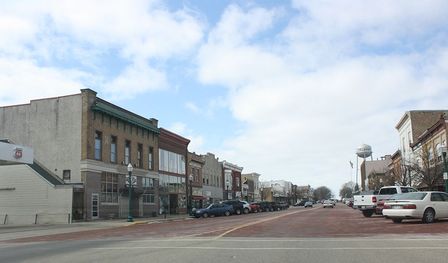 Delavan, Wisconsin: not home to giant Nephilim skeletons.
Delavan, Wisconsin: not home to giant Nephilim skeletons. The Delavan skeletons’ purported sizes, ranging from seven to nine feet tall, with abnormally large skulls, are consistent with other skeletal remains which Marzulli said fit the Nephilim profile.
Locating photographs, notes, maps, and other documentation related to an old excavation is a worthy endeavor that I fully support. I’ve spent time myself trying to piece together whatever information I could to aid in interpreting and understanding past work at sites like Clark’s Point in the Falls region of the Ohio Valley and some 1960s Late Woodland mortuary sites in southern Indiana. A single map or photograph can sometimes have a great impact on one’s ability to construct some framework for understanding the material remains from unpublished or under-published archaeological investigations.
So I think some new evidence about the Delevan skeletons would be a wonderful thing, and I would like to put some cash on the line as well. While Marzulli’s $500 reward for a photograph is not something I can match (I don’t have talk show host money, just Visiting Assistant Professor money), I decided I could chip in something to help the cause. At first I committed to a dollar, but as I did some research on the Delavan accounts and became more and more interested in helping to solve this “mystery,” I decided to double my contribution. Together with Marzulli’s $500, my two bucks will bring the total reward for a Delavan photograph to $502. If that doesn’t push the gas pedal down to the floor, I don’t know what will.
But I have very different expectations than Marzulli about what those photographs, if they exist, will show. SPOILER ALERT: there was nothing giant, mysterious, or particularly unusual about the skeletons either from 1911 or 1912. The 1911 stories that I have seen contain no information that suggests anything but Native American remains disinterred from a mound. The 1912 stories about Delavan, which emphasized a suite of strange cranial features, were composed and spread in the context of the ongoing search for the “missing link” between apes and humans that was the focus of the accelerating study of human evolution. This historical context explains the particular language and claims about the characteristics of the 1912 skeletons that we see in the stories, as well as the headlines.
Let’s look at the accounts.
The Delavan Accounts
Those familiar with the modern mythology of giants have heard of Delevan before: the accounts from Delavan are a staple among those making a claim that a “race” of giants existed in prehistoric North America. A Google search for “Delevan skeletons” returns several pages of websites that have posted, transcribed, or paraphrased an article in the New York Times from May 4, 1912, with the headline “Strange Skeletons Found:”
__
Indications That Tribe Hitherto Unknown Once Lived in Wisconsin.
Special to the New York Times.
Upon opening one large mound at Lake Lawn farm, eighteen skeletons were discovered by the Phillips Brothers. The heads, presumably those of men, are much larger than the head of any race which inhabit America to-day. From directly over the eye sockets, the head slopes straight back and the nasal bones protrude far above the cheek bones. The jaw bones are long and pointed, bearing a minute resemblance to the head of the monkey. The teeth in the front of the jaw are regular molars.
There were also found in the mounds the skeletons, presumably of women, which had smaller heads, but were similar in facial characteristics. The skeletons were embedded in charcoal and covered over with layers of baked clay to shed water from the sepulcher.
Similar stories ran in a number of other newspapers during the spring of 1912. I have transcribed the ones that I’ve located (available here as a pdf). They all say pretty much the same thing in terms of the description of the skeletons: large skulls, sloping foreheads, protruding nasal bones, and jaws like a monkey or an ape. The descriptions that mention the teeth say the front teeth are “regular molars.” Many of the headlines emphasize the “strangeness” of the remains and use phrases like “unknown race.” Two of the accounts actually specify that the skulls were unusually small rather than unusually large.
The 1912 excavations appear to have been conducted in a different mound from the 1911 excavations. I only found one account of the 1911 excavations (Belvidere Daily Republican, April 12, 1911):
__
Fourteen Are Unearthed Beneath Knoll Where Chicagoans Camp.
__
For years it has been suspected that the big mound on which several Chicago church choirs have been accustomed to camp, one after another, in different years, contained rich Indian relics, but no one seemed to make a move toward exploration.
As the result of an argument as to what was hidden in the mound, the owners of the place dug down eight feet and raked out skeletons which are probably the largest specimens of the red race found in southern Wisconsin. Two of the skeletons were found in a sitting posture. All were buried in a stone-floored and walled pit, over which a solid clay slab had been placed.
The skeletons have been preserved intact and will go to the state museum at Madison.
Walworth county has a very large number of the mounds, some of them having been explored, with the result that only a few relics, most of them crude weapons, were found.
I’m not sure exactly what Mazulli is expecting to find in photographs from the 1911 excavations at Delavan, but I’m guessing from the story on his blog that he hopes to use photographic evidence to support his claim that the Delevan skeletons were in the “giant” range of human stature (i.e., over 7’ tall). He claims to have demonstrated that a photo from Catalina Island, California, shows a skeleton from an individual that would have been over 8’6’ tall. I didn’t find any accounts that give height estimates for the Delavan skeletons, so I have no idea where his information about 7’-9’ skeletons comes from. Perhaps there is some newspaper account or source out there that gives these specific height estimates. They certainly don’t appear in the accounts that I found.
Were the remains from Delavan the skeletons of giant Nephilim as Marzulli claims?
No. Here's what the accounts were really trying to describe.
The Delavan Accounts in a Historical Context: The Search for Human Ancestors
The early 1900s was an interesting time in the study of human evolution. Darwin had published On the Origin of Species in 1859, and the hunt was on for fossils that could demonstrate a “missing link” between humans and apes. Neandertal fossils had been known from Europe since the 1820s, but those remains were too similar to modern humans to qualify as a “missing link.” Eugene Dubois had discovered fossils of “Java Man” (later named Homo erectus) in Indonesia in the 1890s. Although Darwin had hypothesized that early human ancestors would be found in Africa, no fossils had yet been located (the first australopithecine, Taung Child, was not discovered until 1923).
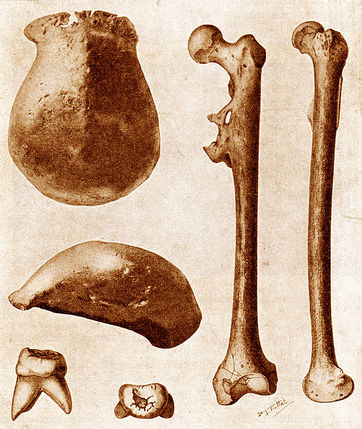 The original remains of "Java Man." Note the sloping forehead.
The original remains of "Java Man." Note the sloping forehead. Stories about human evolution and the remains of Neandertals and “Java Man” were being printed in newspapers in the early 1900s. A 1911 article with the headline “When Man Came on Earth” (Moberly Weekly Monitor, February 3, 1911) describes “the ape-man of Java:”
"He was a little more than five feet tall and stood erect, though still with the strong curve to his back inherited from a quadruped ancestor. He had a heavy face with retreating forehead, bulging teeth, massive jaws and receding chin."
An article titled “Blurred Beginnings of Mankind” (Kansas City Star, March 5, 1911) described the skulls of Neandertals:
"A low, receding forehead topped his skull. The nose was flat, the nostrils large, the jaw heavy, the chin small and receding. Two thick, bony ridges stood over his eyes. The skin may have been copper colored and the hair on it was thick. The large teeth bulged outward. His frame was canted forward a trifle."
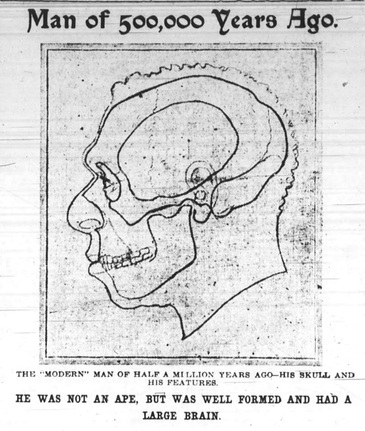
It was in the context of this information about the characteristics of known fossils and the global hunt for the “missing link” that the stories of the Delevan skeleton were written.
The Intent of the Delavan Accounts
I think it is pretty clear that the goal of the 1912 newspaper story was to promote the idea that Delavan skeletons were somehow important to human evolution. That is why the stories describe skulls with sloping foreheads, protruding nasal bones, and monkey- or ape-like jaws. Many of the stories emphasize that the skeletons belong to an “unknown race,” and one headline even proclaims that the skeletons “May Prove Darwin Theory.”
In the 1912 story, there is no mention of the Native American affiliation of the remains (as specified in the 1911 story), and no mention of large stature or body size.
The 1912 description of the skulls was apparently provided by "attorney Maurice Morrissey" from Delavan. I do not know what Morrissey’s agenda was or what his qualifications were for describing skulls, but the features he chose to emphasize certainly resonated with the characteristics of the known “ape-man” fossils that were being described in the press. The identification of the front teeth as “regular molars” makes me doubt that he had any serious anatomical training. He was undoubtedly mistaking well-worn incisors for molars (if the account had been written a few decades prior, it probably would have called the front teeth “double teeth” or used the phrase “double teeth all around”).
The differences between the 1911 and the 1912 accounts from Delavan are telling. While the remains encountered in 1911 and 1912 were probably pretty similar, the stories about the remains were written with very different agendas. The 1911 accounts were of large Native Americans. The 1912 accounts were of a possible human ancestor with all the characteristics one would expect to find in the skeletons of "ape-men."
The similarities between the 1912 descriptions from Delavan and Ellensburg (also from 1912) are striking (more on that later).
What the Giantologists Got Wrong
In this case, it might be easier to address what the giantologists got right:
Wisconsin.
They appear to have gotten the site in the correct state. Other than that, I don't see a whole lot of merit in how the giantologists have treated the Delavan accounts.
Are these the skeletons of giants? I’m honestly not sure where that idea comes from. It is certainly nowhere in the newspaper stories from 1911 or 1912 that I have located. The claim for a 7'-9' height made on Marzulli's webpage is repeated in many other locations on the web that only reference the New York Times article. I honestly have no idea where that piece of the story originates--I do not know if there is some basis for it or if it’s a total fabrication. If someone can point me to a source for the specific height claim I would love to have a look at it.
In some cases, the remains from Delavan have grown even larger. One webpage about Delavan specifies that:
"These alleged findings were first reported on May 4, 1912. It stated that these skeletons had heights which ranged from 7.6 feet up to 10 feet and the skulls were much bigger than the heads of any type of person who lived inside America today. The story also said the skulls had double rows of teeth, six toes on each foot and six fingers on each hand. It was also reported that these bones were believed to belong to beings that could have even been aliens."
Not only have the skeletons gotten taller, but they've grown extra digits, extra teeth, and possibly been extraterrestrials. I shouldn't have to say it, but that description appears to contain considerable embellishments that are not present in the May 4, 1912, story in the New York Times.
The Delavan skeletons have become part of the lore of the new mythology of giants. In the hundred years since their discovery, they have grown in size and become amplified in significance. In reality, however, the stories from Delavan that I have seen appear to describe Woodland-period Native American remains disinterred from artificial burial mounds. The story from Delavan changed from 1911 to 1912 as someone saw an opportunity to attract attention by casting the remains in a light that would make them appear relevant to the unfolding story of human evolution. The reported features that were "strange" about the skeletons were characteristics that made them appear more like a possible human ancestor.
I hope the $502 on the table flushes out some new information about Delavan. I’m supposing that Marzulli is interested in the 1911 excavations because the story from that year actually specified that the skeletons were “probably the largest specimens of the red race found in southern Wisconsin.” The 1912 accounts mention nothing about the size of the skeletons, which makes sense because great height was not associated with fossils of earlier humans (Neandertals and “Java Man”) known in 1912. At any rate, if photographs from the excavation do surface, they will show skeletal remains that fall within the normal range of human variation. They will be of regular height, with regular-sized heads, with regular features of modern humans.
That will be $2 well spent.
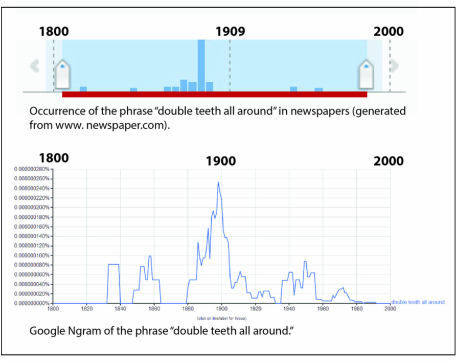

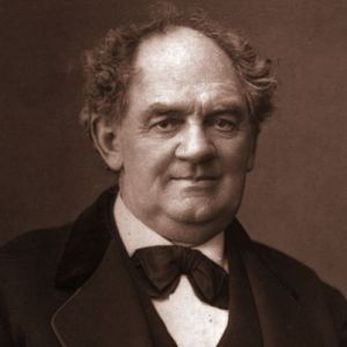
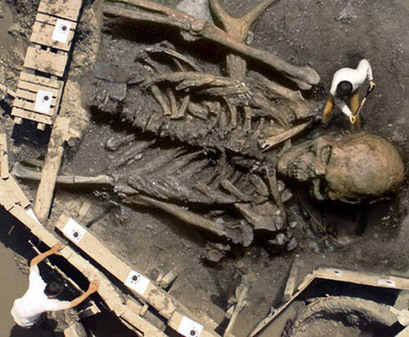
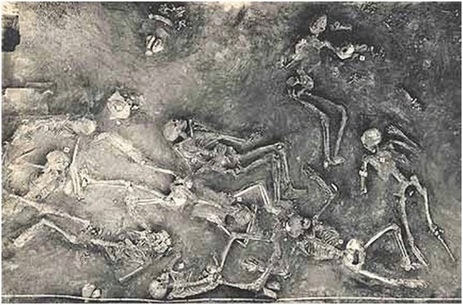


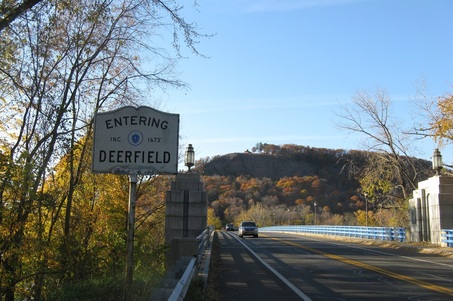
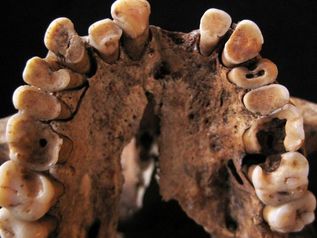
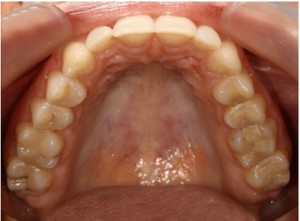
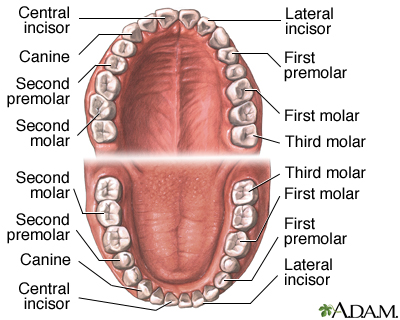
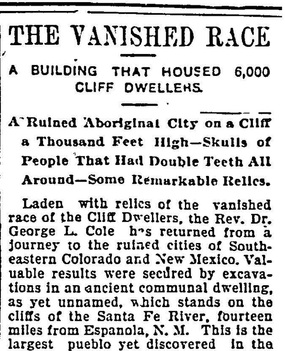
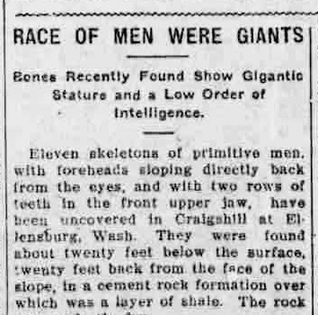

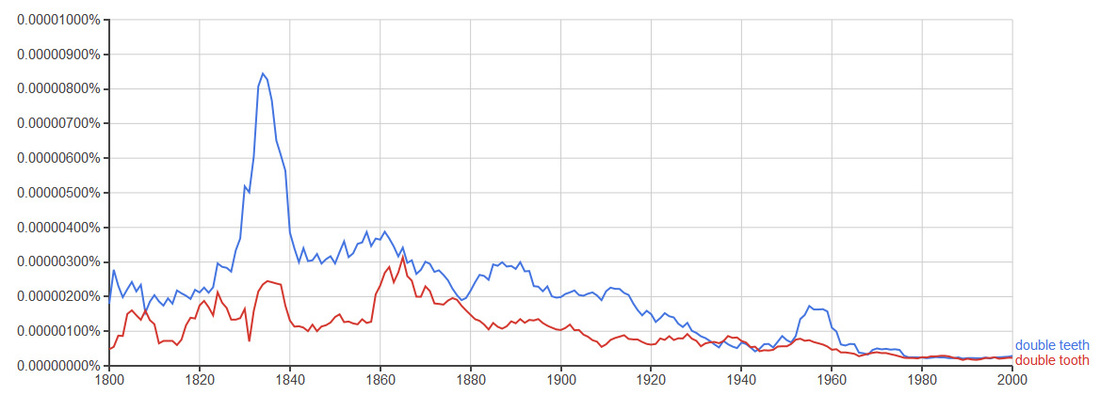
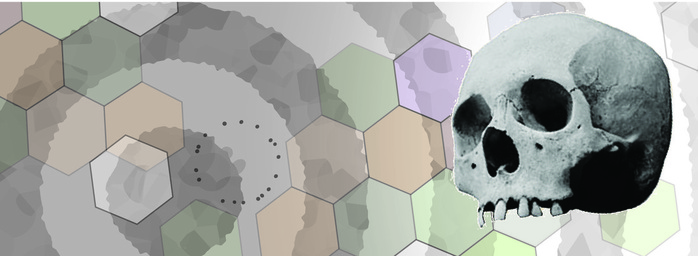


 RSS Feed
RSS Feed
